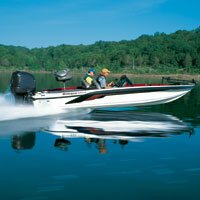A trolling motor is a small electric motor, located on the bow or stern (sometimes both), that’s used for moving a fishing boat through the water quietly, to avoid spooking the fish.
Ratings
Trolling motors are available in 12 volt, 12/24 volt, 24 volt, and 36 volt configurations. More voltage means a larger electric motor, which translates into more useable power at the propeller.
Unlike an outboard engine, a trolling motor’s power output is measured in pounds of thrust, rather than horsepower. The higher the pounds of thrust, the more powerful the trolling motor is.
Therefore, a 36 volt trolling motor that’s rated at 100 pounds of thrust is a lot stronger than a 12 volt trolling motor with 40 pounds of thrust.
Power: More is Better
When choosing a trolling motor, get a unit with the highest output as you can. It’s much better to have extra power and not need it, than it is to need more power—and not have it.
Generically speaking, every 400 pounds of your boat’s weight needs about 5 pounds of thrust from the trolling motor to move it.
Batteries
A trolling motor uses electricity to generate power; this electricity comes from the batteries on your boat. In addition to the battery for starting your boat’s engine, plan on at least one more deep cycle battery for the trolling motor.
Do not use the same battery to start the engine, and to provide power to the trolling motor. Why? After a long day of fishing, the trolling motor will have used up most of the battery. When it’s time to go home, you’ll turn the ignition key only to find that the engine won’t start, ‘cause you drained the battery.
If you’re going with a higher voltage trolling motor, or if you’ll be using the trolling motor for hours on end, you should seriously consider multiple deep-cycle batteries to feed your trolling motor’s voracious electrical appetite.
Shaft Length
The distance from the bow/transom of your boat determines the trolling motor’s shaft length:
Steering
You can steer a trolling motor by hand with a tiller handle, or by foot, with a foot pedal, or with a remote control device. The choice depends on your boat and your personal preference.
- Tiller steer motors are the easiest to install—and to remove—because they clamp to the boat with a couple of thumbscrews. You can also mount a tiller steer trolling motor on the bow, stern, or both if you want to.
- Foot control trolling motors require a folding mounting bracket on the bow—we’ve never seen a foot control motor located anywhere else on a boat. Most foot controls use mechanical cables to move the trolling motor—press your toe down to turn the motor (and the boat) one way, rock your heel back on the foot pedal to maneuver the motor in the opposite direction. You can now control many of the newer trolling motors with small remote control devices that vary in size from a garage door opener, to a small car remote lock and unlock fob that fits on a key chain.
If you’d rather focus on fishing than steering the boat, you can get a trolling motor that steers the boat without any help from you—a high-tech autopilot setup for the serious, well-funded angler. Very cool.
Final Comment
Trolling motors really don’t troll—they’re a means of keeping you fishing.
Read more about saltwater and freshwater fishing accessories


